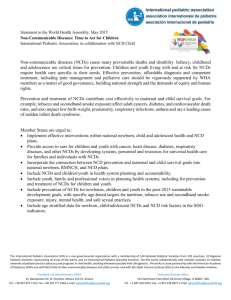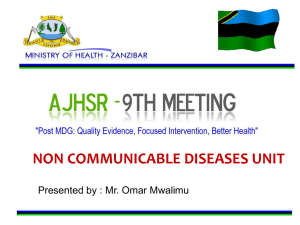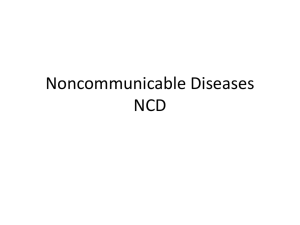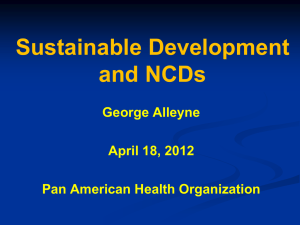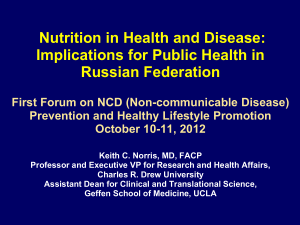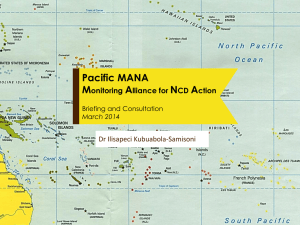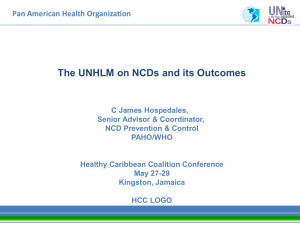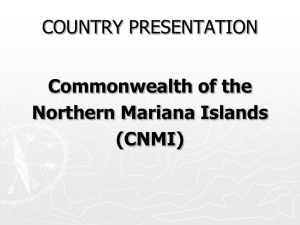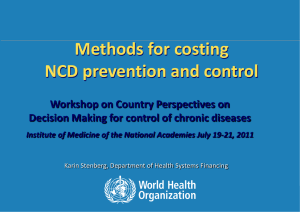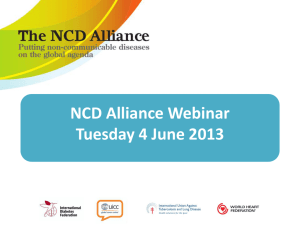PIHOA NCD Presentation 6.27 MB | Posted 17 Jul 2014
advertisement
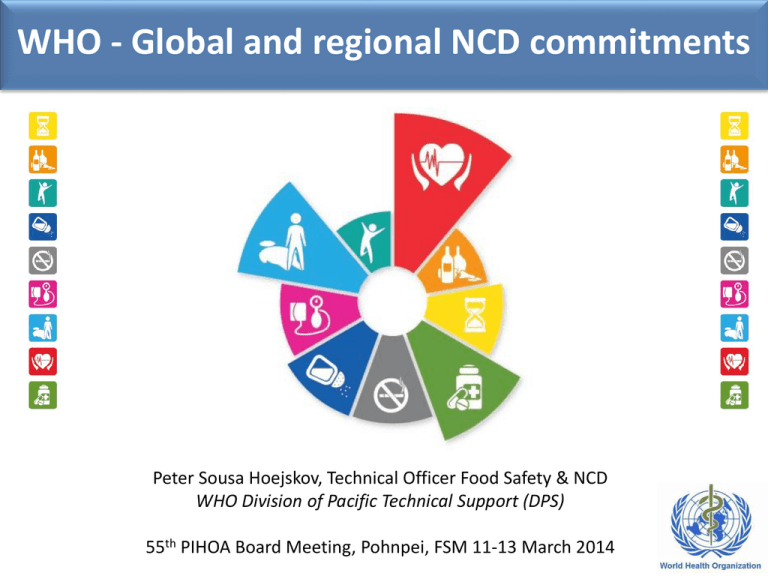
WHO - Global and regional NCD commitments Peter Sousa Hoejskov, Technical Officer Food Safety & NCD WHO Division of Pacific Technical Support (DPS) 55th PIHOA Board Meeting, Pohnpei, FSM 11-13 March 2014 World Health Assembly in 2000: There is a strategic vision on how to address NCDs *Surveillance* Mapping the epidemic of NCDs and risk factors *Prevention* Reducing the level of exposure to risk factors *Management* Strengthen health care for people with NCDs Setting the agenda: Vision and a global road map 2000 2003 2004 2008 Global Strategy for the Prevention and Control of Noncommunicable Diseases Global Strategy on Diet, Physical Activity and Health Action Plan on the Global Strategy for the Prevention and Control of NCDs Global Strategy to Reduce the Harmful Use of Alcohol 2009 WHO Global Status Report on NCDs 2010 2011 Political Declaration on NCDs 2012+ Realizing the commitments made in the Political Declaration Pacific political commitment Pacific Health Leaders Multisectoral leaders Pacific Forum Leaders 1995 Yanuca Island declaration: ‘Healthy Islands’ 2003 Tonga Commitment to Healthy Lifestyle and Supportive Environment 2010 PIHOA: NCD as a medical Pacific Food Summit : emergency in USAPI Agriculture, Health and Trade on Food Security 2011 Honiara Communique on Ministers of Sports NCD Crisis Declaration NCD Crisis declaration supporting NCD UN High Level: Political Commitment on NCD 2013 Apia Communique on NCD Forum Trade and Economic Ministers : NCD Finance Roadmap 2014 Directors of Health: CRP Ministers of Finance and endorsement Health Meeting Commitments from Heads of State and Government 2012: Adopt a global target of a 25% reduction in premature mortality from NCDs by 2025 World Health Assembly 2011: World Health Assembly UN General Assembly The UN High-level Meeting on NCDs was a defining moment for development cooperation: it sets a new global agenda that advances inclusive social and economic development. 2013: WHO Global NCD Action Plan 20132020, including 9 global targets and 25 indicators UN General Assembly NCD Review 2014: Review and assessment of the United Nations General Assembly of the progress achieved in the prevention and control of NCDs The WHO Global NCD Action Plan 2013-2020 unites governments, international partners and WHO around a common agenda Vision: A world free of the avoidable burden of NCDs Goal: To reduce the preventable and avoidable burden of morbidity, mortality and disability due to NCDs by means of multisectoral collaboration and cooperation at national, regional and global levels The WHO Global NCD Action Plan 2013-2020 has six objectives with recommended actions for Member States, international partners and WHO Objective 1 To strengthen international cooperation and advocacy to raise the priority accorded to prevention and control of NCDs in the development agenda and in internationallyagreed development goals Objective 2 To strengthen national capacity, leadership, governance, multisectoral action and partnerships to accelerate country response for the prevention and control of NCDs Objective 3 To reduce exposure to modifiable risk factors for NCDs through creation of healthpromoting environments Objective 4 To strengthen and orient health systems to address the prevention and control of NCDs through peoplecentred primary health care and universal health coverage Objective 5 To promote and support national capacity for high-quality research and development for the prevention and control of NCDs Objective 6 To monitor the trends and determinants of NCDs and evaluate progress in their prevention and control Targets for NCD prevention and control TOBACCO FREE PACIFIC At the World Health Assembly in May 2013, Member States adopted the Comprehensive Global Monitoring Framework for the Prevention and Control of NCDs, including a set of 25 indicators What is next? Immediate actions for Member States 2014-2015 Action Area Governance Risk factors Health systems Surveillance Set national targets for 2025 in 2013, taking into account the 9 global targets Develop national multisectoral NCD policies and plans to attain national targets for 2025, by addressing the three major components of the NCD strategy Finalize and endorse Crisis Response Plans (CRP) What is next? Priority actions recommended for Member States to reduce the exposure of populations and individuals to risk factors for NCDs Action Area Implement interventions identified by WHO as "best buys" using WHO tools: – – – – Governance Risk factors Tobacco use: Harmful use of alcohol: – – Health systems – Surveillance Tax increases Smoke-free indoor work places and public places Health information and warnings about tobacco Bans on adverting and promotion Tax increases on alcoholic beverages Comprehensive restrictions and bans on alcohol marketing Restrictions on the availability of alcohol Unhealthy diet and physical inactivity: – – – – Salt reduction through mass media campaigns and reduced salt content in processed foods Replacement of trans-fats with polyunsaturated fats Public awareness programme about diet and physical activity Marketing of foods and non-alcoholic beverages to children What is next? Priority actions recommended for Member States to enable health systems to respond more effectively and equitably to the health-care needs of people with NCDs Implement interventions identified by WHO as "best buys" into the basic primary health care: Action Area Governance Risk factors Health systems Surveillance Health system strengthening is key: – Prevention of liver cancer through hepatitis B immunization – Prevention of cervical cancer through screening and treatment of pre-cancerous lesions – Multidrug therapy to individuals who have had a heart attack or stroke and to persons with a high risk of a cardiovascular event in the next 10 years What is next? Priority actions recommended for Member States to quantify and track NCDs and their determinants (as it provides the foundation for advocacy, national policy and action) Action Area Governance Risk factors Health systems Surveillance Implement the WHO Framework for NCD Surveillance, covering – monitoring of risk factors and determinants, – outcomes (mortality and morbidity) and – health system response Integrate into the national health information systems Develop national targets and indicators, based on Pacific targets, the WHO recommendations and WHA Resolutions The WHO Framework for NCD Surveillance quantifies and tracks exposures, outcomes and health systems response Action Area A WHO Framework for NCD Surveillance Exposures: – Behavioural risk factors: tobacco use, physical inactivity, harmful use of alcohol and unhealthy diet – Metabolic risk factors: overweight/obesity, raised blood pressure, glucose & cholesterol. – Social determinants: education, material well being, access to health care Outcomes: – Mortality: NCD specific mortality – Morbidity: cancer incidence and type Health System Response: – Interventions and health system capacity: infrastructure, policies and plans, access to key health care interventions and treatments, partnerships. Governance Risk factors Health systems Surveillance Indicators Vital Reg with COD Mortality from main NCDs STEPS GSHS Harmful use of alcohol (3) Low fruit and veg intake Physical inactivity in adults Cancer incidence by type Cancer Registry Tobacco use in adolescents Raised blood glucose/diabetes Raised blood pressure Overweight and obesity in adults Overweight and obesity in adolescents Raised total cholesterol GYTS Saturated fat intake Tobacco use in adults GATS Physical inactivity in adolescents Salt intake FF Surveys Indicator Vital Registration Cancer Registry STEPS SARA/ facility data NCD Capacity survey Essential NCD meds and technologies Hepatitis B vaccine HPV vaccine Cervical cancer screening Drug therapy and counseling Food Freq Surveys Marketing to children Access to palliative care Policies to limit saturated fats and eliminate trans fat Set national targets and measure results Member States are encouraged to adopt the global and Pacific voluntary targets as national targets National adaptation should be guided by: o Current performance, o Current level of exposure o Programmes planned and in place WHO is developing a Toolkit on NCD Surveillance, which will include a module on setting national targets and measuring results Pacific Crisis Response Plans (CRP) • A framework to prioritize action in the short run (1-2 years) • Based on very cost-effective interventions (“Best Buys”) • Helps development partners focus support and technical assistance • CRPs are not additional NCD plans! CRISIS RESPONSE PLANS (CRP) in PICs Tobacco Control - Tobacco Free Pacific Healthy Diet – Salt reduction & Fruits and Vegetables CVD Risk Management & Counselling - Package of Essential NCD (PEN) Services 3 Areas; 15 Strategies and 15+ Milestones Summary • NCD is not only a threat to public health, but also to socio-economic development and prosperity • Targets and the way forward are clear – Countries need to scale up action individually and collectively • Surveillance, prevention and management of NCDs go hand-in-hand • CRPs help countries prioritize and progress towards the long-term goal of 25x25 Thank you

